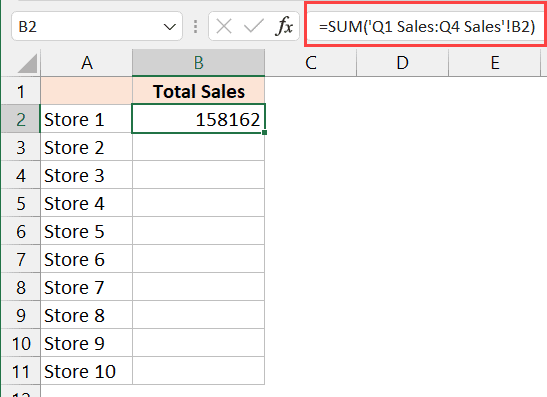5 Easy Ways to Sum Across Excel Sheets

One of the most common tasks when working with spreadsheets is summarizing data from multiple sheets. Excel offers powerful features to effortlessly sum values across different sheets. This not only saves time but also reduces the chances of human error when handling large datasets. Let's dive into five methods you can use to sum across Excel sheets, making data analysis more efficient.
1. Using 3D References

3D references allow you to perform calculations across multiple sheets in one formula. Here’s how you can use them:
- Click on the cell where you want the total sum to appear.
- Type
=SUM(. - Then, instead of selecting a single range, click the first sheet tab, hold Shift, and click the last sheet tab you want included. This selects all sheets in between.
- Drag to select the range of cells you want to sum across all these sheets.
- Press Enter to complete the formula.
The formula will look something like =SUM(Sheet1:Sheet3!A1), which adds the value of cell A1 from Sheet1 through Sheet3.
✏️ Note: Ensure the cell references and sheet names are consistent across sheets for accurate summation.
2. Consolidating Data with SUMIF

Excel’s SUMIF function can be particularly handy for summing data based on specific criteria across sheets. Here’s how to do it:
- Select the cell where you want the result.
- Type
=SUMIF(. - Provide the range argument from one sheet where the criteria will be checked, e.g.,
‘Sheet1’!A1:A100. - Add the criteria, e.g.,
“Region1”. - Specify the sum range from the same sheet, e.g.,
‘Sheet1’!B1:B100. - Use the
+operator to add similar SUMIF functions for other sheets, repeating the process with updated sheet references.
Example formula: =SUMIF('Sheet1'!A1:A100,"Region1",'Sheet1'!B1:B100)+SUMIF('Sheet2'!A1:A100,"Region1",'Sheet2'!B1:B100)
3. Named Ranges for Dynamic Summations

Named ranges can make your formulas cleaner and more dynamic. Here’s how to utilize them:
- Define a named range for each sheet. For example, name cells A1:A100 on Sheet1 as “SalesSheet1”.
- Create a master sheet with names for each sheet’s range.
- Use the SUM function with these named ranges, like
=SUM(SalesSheet1,SalesSheet2).
💡 Note: When sheet names contain spaces, use single quotes around the name, e.g., 'Sheet 1'!A1.
4. Using Power Query

Power Query is Excel’s data transformation tool that can help you consolidate data from multiple sheets:
- Go to Data tab > Get Data > From Other Sources > From Microsoft Query.
- Connect to your workbook and select all relevant sheets.
- Merge the queries by appending them into one.
- Load this combined data into a new sheet where you can sum the relevant columns easily.
5. Pivot Tables for Multiple Sheets

Pivot Tables can handle data from various sources, including multiple sheets. Here’s how:
- Create a Pivot Table using data from one sheet as your base.
- Go to Analyze tab > Change Data Source.
- Select all sheets you want to include in your Pivot Table.
- Adjust the Pivot Table to show sums or averages across the sheets.
By following these steps, you can easily incorporate and analyze data from multiple sheets within your workbook, providing a comprehensive view of your dataset.
In summary, Excel offers a range of methods to sum across sheets. From simple 3D references to more advanced tools like Power Query and Pivot Tables, there’s a solution for every level of complexity. Whether you're looking to streamline your workflow or tackle complex data analysis, these methods enhance efficiency, accuracy, and the overall flexibility of your spreadsheet operations.
Can I sum values from specific cells across sheets?

+
Yes, by using 3D references, you can sum specific cells across sheets. Simply use the formula =SUM(Sheet1:SheetX!A1) where “A1” is the cell reference and “SheetX” is the last sheet you want to include in the sum.
How do I update sums when adding new sheets?

+
If you use 3D references, the sum updates automatically. For other methods, you would need to manually update the formulas to include the new sheet’s data.
Are there any limitations to summing across sheets?

+
The limitations are generally related to the complexity of your workbook. Excel has limits on the number of sheets and the size of ranges you can reference, but these are typically beyond normal use cases.



